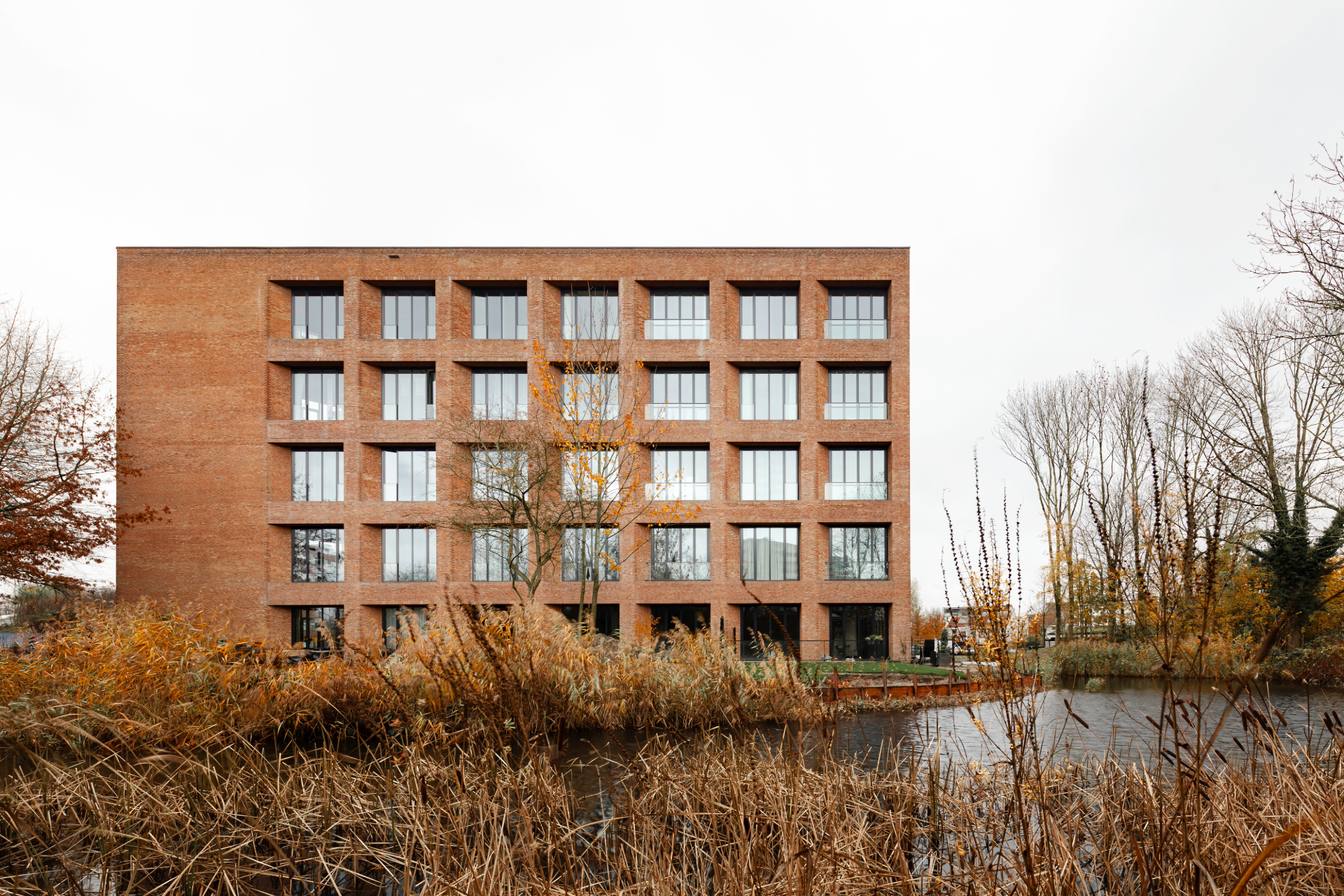







































































location: Breda
year: 2020
size: 5500 m2
function: housing
client: Reales Ontwikkeling
In the 1970s, the Koninklijke Coöperatieve Cosun U.A. (Royal Cosun/de Nederlandse Suiker Unie) was looking for a new head office in Breda. The location they eventually acquired is on the western edge of Breda. The surrounding residential areas were not yet there at the time. The Suikerunie commissioned Wim Quist to design a suitable head office, which was completed around 1975. In the original design, the Suikerunie site was opened up on the west side. The location, which had a green, park-like layout, was entered through an entrance gate with a garage and porter’s house on either side. The employees and visitors were escorted to the entrance which is located in the cutout on the southwest side of the building. The diagonal positioning of the building in relation to the plot arises from this. Landscaping, visual art and buildings formed a carefully designed ensemble.
The situation has remained virtually unchanged for more than twenty years. A residential area and a police station were built to the north and east of the plan, respectively. Around the turn of the century, the location was densified. Plans have been made for four office buildings, two of which were eventually completed. In 2011, Cosun / Suikerunie left their head office and the building has been vacant ever since. The garage and porter’s house have now been demolished, the visual arts have disappeared, the ground level largely has a low-grade use with parking and the Zuilenstraat that opened up the park no longer exists.
The Cosun site will be revived in the coming years and transformed into a residential area. The parking will be solved underground and the residential buildings will be placed in a park again. Cosun 1 / Suikerunie is the first step in the transformation.
In addition to a valuation of the building carried out by the municipality, we collected documentation from various books, the drawing archive of the municipality of Breda and we visited Wim Quist a number of times to discuss the building and our plans. We were able to formulate clear starting points and points for attention for the transformation.
The building is basically a clear cube that stands in the park with an angular rotation. The facades are made of masonry with and a uniform infill that gives the building a modest expressiveness. In contrast, the facade in the cut has a high-tech appearance in two layers: a fully glazed facade and movable slats in front of it that serve as sun protection. Preserving the striking, solitary character and the expressive facades of the building have been important principles. The rational facade image that has been carefully worked out down to the smallest detail: apparent simplicity but very cleverly made. The striking contrast in material, colour, design and appearance between the solid brick outer shell on the one hand and the airy construction of the ‘lining’ on the other: both with their own pattern, layering, dynamics and expression.
The structure of the facade, cores and two columns form the basis, the rest of the floors are freely divisible. The current office layout with partition walls and lowered ceiling contributes little to the character of the building and can be removed. Due to the shape that was not originally conceived for housing and the heights of the floors (almost 4 metres), the building lends itself well to spacious, special apartments. An important point is the dissolution of the outside spaces in the building near the masonry facade, so that the expressiveness and rhythm are not disturbed.
We have made a new layout that is based on supporting functions around the core and living spaces as much as possible on the facade. This creates a great diversity of apartments, also because we want to activate the basement and the roof. We arrive at 23 types on 39 apartments ranging from 60-150 m2. The sharp angles give rise to special typologies and floor plans. At the suggestion of Wim Quist, we propose outdoor spaces near the masonry facade as winter gardens on the corners and in other places where they are needed. For the facade in the cut, we also want the outdoor spaces to be the sun blinds that will become an integral part of the new facade. We also want to integrate green here, another Quist idea.
In the original urban design, Cosun 1 / Suikerunie was the end of a route. The facade in the cut was where the building opened up at the end of that route and where one was escorted to the entrance. In the new situation, the park layout is no longer a route, but part of an ensemble of buildings with multiple directions and routes. The west facade turned out to be a better and clearer place to open up the building. In this new situation, the facade in the cut still opens up, but the functionality lies more in the private sphere, view and outdoor spaces. The entire building has a basement. This basement can partly be given a functional interpretation with storage rooms and technical spaces, but it is also large enough to also add part to the houses and thus create double-height houses with voids. We also want to activate the roof: you have a beautiful view and it is not being used now. We will replace the existing roof structures with a single, lower volume. You can get here from five houses on the 4th floor and they have one floor and an accessible roof garden. The construction is made of metal with a slatted facade. It is subordinate to the building but does refer to it in color and rhythm.
Although the windows in the masonry facade are fitted with triple glass, which was unusual at the time it was built, there are no parts that can be opened and they are composed so that adjustment is impossible. These fronts will be replaced by new, floor-to-ceiling window frame. We have three types of windows in the plan: fixed glass, fronts with parts that can be opened and folding windows at the winter gardens. In terms of profiling and appearance, the fronts are such that they appear identical, regardless of the type. In this way we get a facade image that remains calm and unambiguous, just like in the existing situation.
The current facade in the cut is characterized by its layering, detailing and the high-tech appearance that contrasts with the traditional masonry. We want to maintain that contrast: a new open facade will be built in the same rhythm as the existing one. We use the construction that supports the existing slats to add a second layer in the form of perforated steel screens. The residents can allow these to grow over, creating a pleasant green atmosphere that contrasts with the heavy masonry facade.
Lower demands are placed on transformation with regard to energy management than on new buildings. By using smart installations and heat-cold storage in the ground, we are still able to meet the new-build requirements. But more importantly: being able to (re)use a building for as long as possible due to the functional freedom to rearrange it and because it has an unmistakable quality that means that no one tends to tear it down is in our view the most sustainable thing there is.
landscape: Buro Beuk
contracteer: Ouwehand Bouw
structural engineer: H4D
advisor installations: Huygen Installatie advies
advisor building physics: Cauberg Huygen
photographer: Sebastian van Damme
Anouk Muller
Archives Municipality Breda (1974)